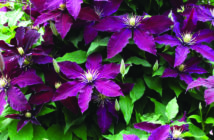If you are considering planting any trees this spring, please consider native species. A native tree I have always enjoyed (if planted in the right location) is the sweetgum or Liquidambar styraciflua. That’s right, the sweetgum is a native tree. A tree is considered “native” if it existed in Adams County prior to European settlements. As a matter of fact, the sweetgum is considered a living fossil.
Today there are three existing species: one native to Taiwan, one native to Turkey, and one native to the Americas. The range for the American sweetgum is north to Connecticut, south to Florida, and west to the eastern part of Texas. The sweetgum also grows in Central America from Mexico to Panama.
The sweetgum is considered a moderately fast growing tree that will typically reach mature heights of 70 feet. If planted in an unrestricted area, the crown of the sweetgum will develop into a beautiful, symmetrical pyramidal shape. The bottom width of the pyramid can reach a spread of 50 feet.
The sweetgum leaf is star shaped with five to seven points. The leaves are a glossy dark green during spring and summer and change to a traffic-stopping array of reds and oranges in the fall. The young limbs of the sweetgum develop corky ridges very similar to the winged euonymus.
The sweetgum likes full sun and moist, well-drained soil with a pH of 6-7.
The sweetgum gets its name from the light brown sap it produces. Native Americans chewed the hardened clumps of the sap as an early form of chewing gum, in addition to other uses. The sweetgum was first documented during the Spanish explorer Cortez’s exploration of the Aztec Empire. The Aztecs combined the sap with an herb they referred to as tobacco. Smoking this combination induced relaxation and sleep.
The sap has also been used to treat urinary tract infections, tuberculosis, gonorrhea, and dysentery. Mixing the sap with tallow or lard was once a common solution for many skin problems, including ringworm.
Today sweetgum is highly valued for its timber. It is second in production only to oak as a hardwood. The almost-perfect straightness of sweetgum trunks make them ideal for veneer wood. Sweetgum is used in cabinet making, interior trim, boats, and musical instruments.
As a matter of fact, the sweetgum is considered a living fossil.
The sweetgum makes an excellent landscape specimen. Being a native species, it requires less maintenance and has a built-in capacity to handle environmental stresses such as drought. Its fall display of color can be breathtaking, summer shade inviting, and the unique sculpturing in the winter with its winged branches make the barren landscape a little less dreary.
However, with most things in nature, there’s a tradeoff. For the sweetgum, it’s its fruit. Sweetgum produces a small, round spiny fruit that resembles mace, the medieval weapon carried by knights. For many, the fruit is considered a nuisance and produces excess trash that becomes a burden. However, the fruit is actually a food source for squirrels and chipmunks, and numerous songbirds also dine on the seed within the fruit pods.
If you need another tree in your landscape, think native and consider sweetgum. But remember, they look their best when planted in an unrestricted location.




